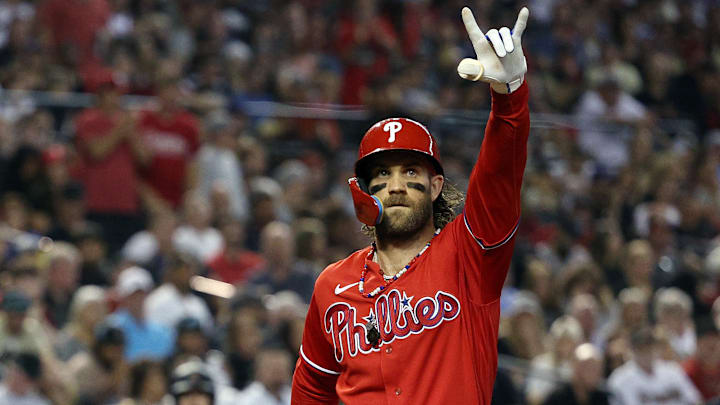In the storied, nearly century-and-a-half history of the Phillies, some of baseball's greatest have roamed the outfield in red pinstripes. Purely WAR-fueled lists are out there, and this isn't that — is Tommy Hunter really on par with Ryan Howard?
To measure the greatest outfielders in Phillies history, the critic's gaze must roam beyond the entire stat sheet to encompass a player's entire impact on the franchise. Postseason contributions, clutch plays, clubhouse leadership, consistency, and where a player stood next to his peers all play a role in greatness.
In case you missed it, we've already ranked the five greatest catchers, first basemen, second basemen, shortstops, third basemen, starters, and relievers in Phillies history.
Before we get into the list, here is a trio of honorable mentions who didn't quite make the top five, but deserve inclusion in any conversation of all-time great Phillies outfielders.
First is Greg Luzinski, a key cog of the 1980 team. A four-time All-Star across 11 years in the organization, Luzinski's peak brought him two runner-up positions in the National League MVP race as a fixture in the middle of the lineup. His best season came in 1976 when he launched 39 long balls and scorched his way to a .988 OPS.
Luzinski's career 130 OPS+ is elite, and though he wasn't known for his glovework, he still amassed 26.4 WAR. That's admittedly less than men like Johnny Callison (38.4 WAR) and Del Ennis (32.5 WAR), but neither had quite the same sheer dominance at their peak as Luzinski. And neither brought a World Series championship home to Philadelphia. He will be considered by the Hall of Fame's Era Committee in 2025.
Callison, a three-time All-Star with 38.4 WAR and a career 115 OPS+ is next. Like Luzinski, he easily could have been included in the top five. A Phillie from 1960 to 1969, he inherited Richie Ashburn's legacy as the team's preeminent player. In 1964, he was the MVP runner-up, beating out legends in their prime like Lou Brock, Willie Mays, Frank Robinson, and Roberto Clemente.
Ellis is the third honorable mention that didn't quite make the cut. An 11-year Philly vet, Ellis made three All-Star squads and racked up a 29.9 WAR and 117 OPS+. He was an RBI machine, leading baseball with 126 ribbies in 1950 and knocking in more than 100 seven different times in his career. He was one of the biggest power threats of his era, though his career was abbreviated: in just 11 full seasons, he hit 288 home runs, according to Baseball Reference.
Because fielding gloves were not even common in baseball until the 1890s and the game was markedly different following the turn of the century, 19th-century Phillies stars like Ed Delahanty and Sam Thompson are not given their due on this list. Doubtlessly they both deserve consideration on a similar list with broader parameters.
And there are of course other names. Some might say Pat Burrell deserves consideration, for a career of mashing that culminated in the fall of 2008. Whatever else there is to be said about Lenny Dykstra, he was the best of the best for a few years and brought home the 1993 pennant. Someone like Cy Williams, one of the greats of the 1920s, was so dominant that he can't be ignored.
Perhaps one of the Phillies' current youngsters will wind up on this list one day; the future is certainly bright for Brandon Marsh and Johan Rojas. Then again, at one point in time, someone was probably writing a similar listicle wondering where, when all was said and done, Dominic Brown would wind up landing.
But heading into spring training 2024, here are the five greatest outfielders in Phillies history.
